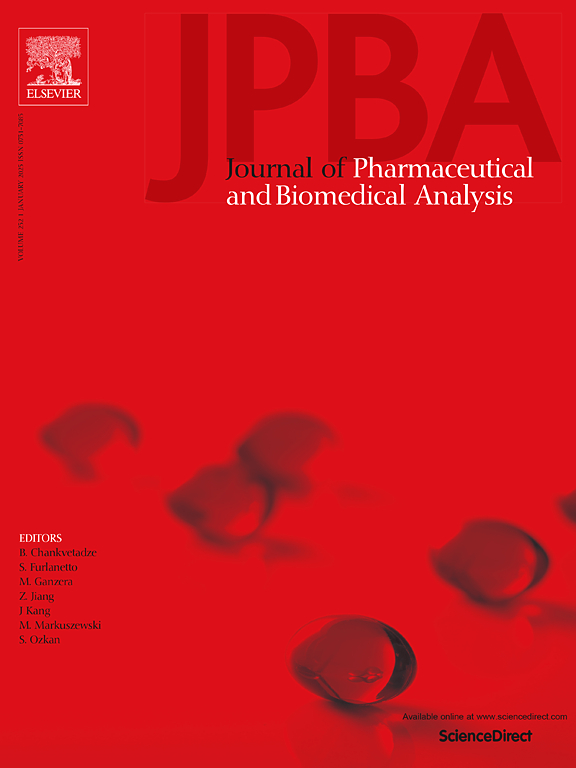Single trichome phytocannabinomics of two different cannabis varieties
IF 3.1
3区 医学
Q2 CHEMISTRY, ANALYTICAL
Journal of pharmaceutical and biomedical analysis
Pub Date : 2025-03-22
DOI:10.1016/j.jpba.2025.116836
引用次数: 0
Abstract
The present study investigates the phytocannabinoid profiles of Cannabis sativa L. by analyzing individual glandular trichomes from both a medicinal cannabis variety (FM2) and a high-CBD (cannabidiol) hemp variety. The analysis was performed using an untargeted metabolomics approach (phytocannabinomics) that enabled the identification of nearly 70 phytocannabinoids in single trichomes, a significant improvement over previous studies, which typically analyzed pooled or enriched trichome fractions. For comparison, the phytocannabinoid profiles of whole inflorescences were also examined. Results showed that the profiles of single trichomes and whole inflorescences were similar in terms of the number and distribution of cannabinoids, with CBD-type compounds being the most abundant. The study revealed a diverse array of carboxylated and decarboxylated cannabinoids, including several homologs of CBD, tetrahydrocannabinol (THC), and cannabigerol (CBG). Although the absolute quantities of cannabinoids varied, the CBD to THC ratio was found to remain consistent across both single trichomes and whole inflorescences, suggesting that the genetic chemotype largely dictates the cannabinoid composition. Statistical analysis indicated minor significant differences between single trichomes and inflorescences, likely due to developmental stage or other biological factors influencing cannabinoid accumulation. This work represents the first successful analysis of phytocannabinoids at the single-trichome level and provides new insights into the chemical diversity of Cannabis sativa L. at a microscopic scale. Additionally, the three characteristic cannabis flavonoids, cannflavin A, B, and C, with important biological activities, including anti-inflammatory, anti-viral, anti-cancer, and anti-parasitic effects, were surprisingly found in the isolated trichomes. These findings offer new insights into the metabolic diversity of cannabis trichomes and the distribution of biologically active metabolites.
求助全文
约1分钟内获得全文
求助全文
来源期刊
CiteScore
6.70
自引率
5.90%
发文量
588
审稿时长
37 days
期刊介绍:
This journal is an international medium directed towards the needs of academic, clinical, government and industrial analysis by publishing original research reports and critical reviews on pharmaceutical and biomedical analysis. It covers the interdisciplinary aspects of analysis in the pharmaceutical, biomedical and clinical sciences, including developments in analytical methodology, instrumentation, computation and interpretation. Submissions on novel applications focusing on drug purity and stability studies, pharmacokinetics, therapeutic monitoring, metabolic profiling; drug-related aspects of analytical biochemistry and forensic toxicology; quality assurance in the pharmaceutical industry are also welcome.
Studies from areas of well established and poorly selective methods, such as UV-VIS spectrophotometry (including derivative and multi-wavelength measurements), basic electroanalytical (potentiometric, polarographic and voltammetric) methods, fluorimetry, flow-injection analysis, etc. are accepted for publication in exceptional cases only, if a unique and substantial advantage over presently known systems is demonstrated. The same applies to the assay of simple drug formulations by any kind of methods and the determination of drugs in biological samples based merely on spiked samples. Drug purity/stability studies should contain information on the structure elucidation of the impurities/degradants.

 求助内容:
求助内容: 应助结果提醒方式:
应助结果提醒方式:


